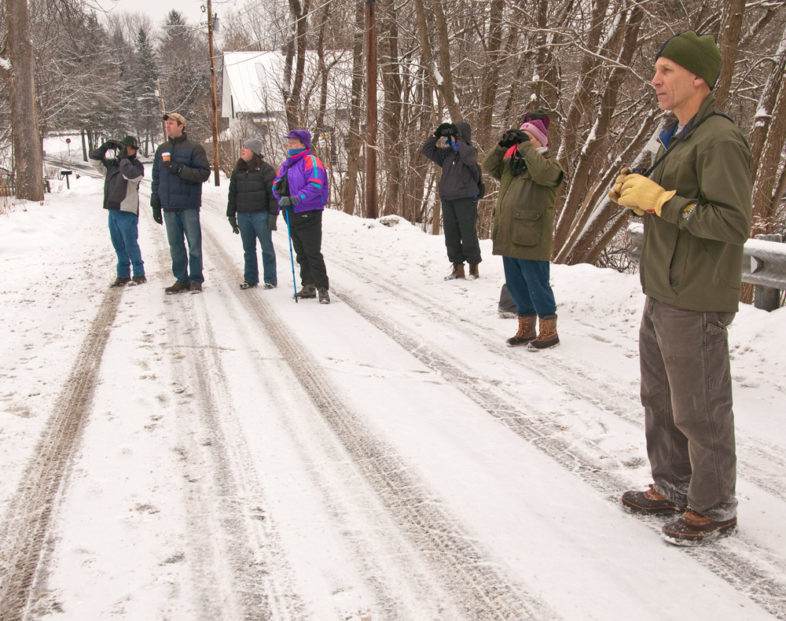
Chris Rimmer and volunteer birders conducting the annual Hanover-Norwich Christmas Bird Count on Hopson Road in Norwich, New Year’s Day. © Jim Block – jimblockphoto.com
The gloves are down, and the Norwich 2019 Year of the Bird is underway. This is an informal (but serious) challenge to birders—experts and novices, professionals and amateurs, hardcores and wannabes, from near and far—to explore the avian diversity of Norwich, get outdoors, have some fun, share the thrill of discovery, and do some learning in the process. Can we document 175 species within the town’s borders during 2019? The answer is an unequivocal yes, but it will require a concerted effort by many, attainable only through hard work, with an abundance of good luck and diligent reporting practices.
Why Norwich? Well, why not? Many birders frequent the town (and a few live here), regularly scouring its forests, thickets, fields, wetlands, and waterways. From the Coop Community Gardens in the south to Campbell Flat in the north, Ompompanoosuc River Flats in the east to Tigertown Road’s wooded wetlands in the west, Norwich is a bird-rich town. And, lying along the Connecticut River, it attracts a multitude of migratory species—both water- and land-based—many of which are simply passing through and stopping to rest or refuel during their spring and fall migrations. Who knew that Vermont’s first-ever record of Marbled Godwit, a spectacular long-distance migrant shorebird, would come from Norwich?? Or that Tundra Swans, Glossy Ibis, White-eyed Vireos, and even a Golden-crowned Sparrow have been found in town? What other avian surprises await discovery??
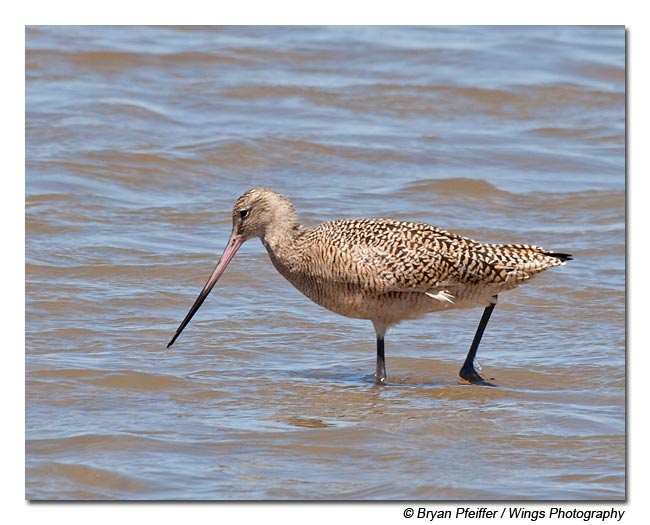
Marbled Godwit, a species only twice recorded in Vermont, with the first record from Norwich on 30 May 2011 by local birders Spencer and Doug Hardy. © Bryan Pfeiffer bryanpfeiffer.com/photography
A small group unofficially kicked off Norwich 2019 Year of the Bird on New Year’s morning, gathering in front of Dan and Whit’s General Store, braving rain showers and an inch-plus of fresh, wet snow to ring in 2019. Participating in the annual Hanover-Norwich Christmas Bird Count (CBC), whereby every bird seen or heard is tallied within a 15-mile diameter circle, the group spent 90 minutes scouring thickets, woods and feeders along a route that followed the popular 1.5-mile “Dan and Whit’s loop”. Avian activity was on the quiet side, but human spirits were high, and we managed to find 12 species, which included the expected cast of local winter residents. Six White-throated Sparrows were noteworthy, as this “half-hardy” species normally winters south of the Upper Valley. Other CBC birding teams scattered throughout Norwich that day tallied a total of 30 species within town, a great start towards our 175-species goal.
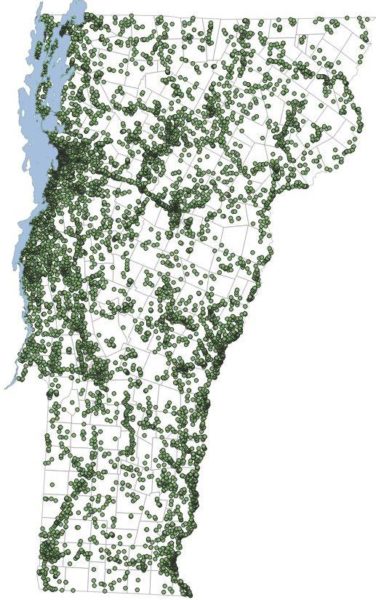
Vermont eBirders submitted checklists from over 10,000 locations representing nearly every town in Vermont in 2018.
Because keeping careful track of yearlong sightings throughout Norwich will be critical to know where we stand, we’ll use Vermont eBird, a real-time, online checklist program that has revolutionized how the birding community reports and accesses information about birds. Launched in 2002 by the Cornell Lab of Ornithology and National Audubon Society, 2019 marks the 15-year anniversary of Vermont eBird, which is managed by VCE as part of our Vermont Atlas of Life and is the very first state portal for eBird. In just a decade-and-a-half, the checklists shared by bird watchers have helped make Vermont eBird the largest citizen science biodiversity project in the state. To date, 7,460 Vermont eBirders have submitted nearly 311,000 complete checklists, representing all 384 species of birds ever reported from Vermont. Worldwide, more than 390,000 eBirders have contributed over 500 million bird sightings on nearly 28 million complete checklists, representing 10,371 species across every country on earth!
To be clear, the data amassed by eBird aren’t just for fun. They contribute hugely to science and conservation. During 2018, eBird data made possible dramatic advances in the understanding of bird populations. The result of years of hard work by citizen scientist birders is eBird Status and Trends—detailed information for over 100 species of North American birds, providing an unprecedented data trove for conservation. Let’s add to this wealth of information in 2019 and make Norwich’s bird populations the best-known in Vermont!
OK, how exactly do birders contribute their sightings to Norwich 2019 Year of the Bird? It couldn’t be easier. If you don’t already have a Vermont eBird account, setting one up is straightforward. Just go to the eBird home page, watch a 3-minute introductory video via the “Learn More” tab, then hit the “Get Started” tab, and you’ll be off to the races with your own eBird account through the Cornell Lab. From there, you can learn how to share any Norwich-based eBird checklist with the Norwich Bird Questers account by visiting the newly-created Norwich Quest web page on VCE’s web site.
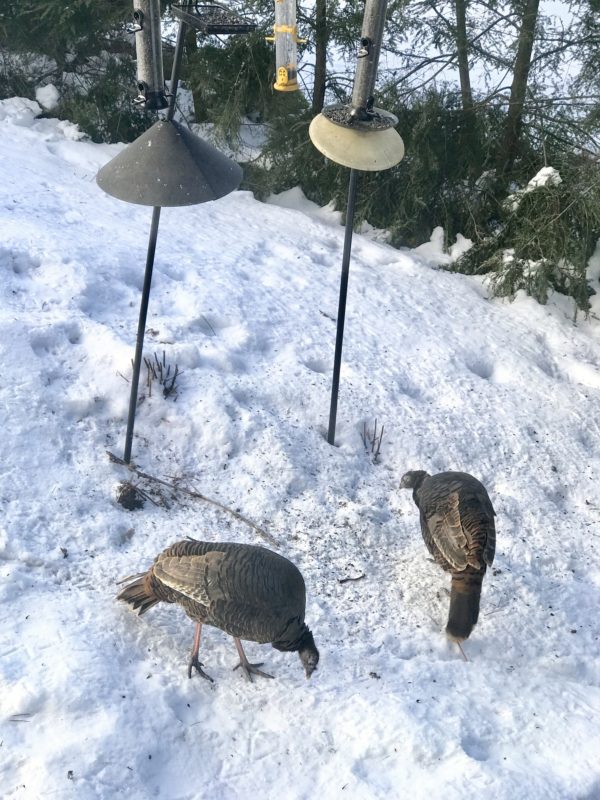
Two of the abundant and ubiquitous Wild Turkeys frequenting bird feeders, fields and woodlands this winter. © K.P. McFarland – kpmcfarland.com
Norwich 2019 Year of the Bird is very simply meant to engage and inspire birders of all sorts to pay attention, and to keep track. The goal of 175 species in a single calendar year? Arbitrary, definitely a stretch, but doable. Everyone likes a challenge, a quest, maybe even some friendly competition. Set your own goals. Can you find 100 species yourself? Can you identify 25 “lifers” in 2019— species that you’ve never before encountered?
Stay tuned for forthcoming details about Norwich 2019 Year of the Bird. We’ll feature a different “target species” each month and encourage everyone to find it. VCE will offer a hands-on eBird workshop or two during the weeks ahead, so don’t fear if this checklist tool doesn’t immediately make sense to you. We’ll also offer periodic outings to various birding “hotspots” in Norwich, and/or excursions to see especially exciting birds that have been found. For now, grab your binoculars and field guide, and start keeping track of what you see in town (and everywhere else). Whether it’s the Wild Turkeys scratching under your feeder, the Hairy and Downy Woodpeckers on your suet, or northern nomads like Bohemian Waxwings and Pine Grosbeaks on your crab apples, there are many avian discoveries to be made. And, here’s another birding challenge — let’s together amass 1,500 eBird checklists for Norwich in 2019!
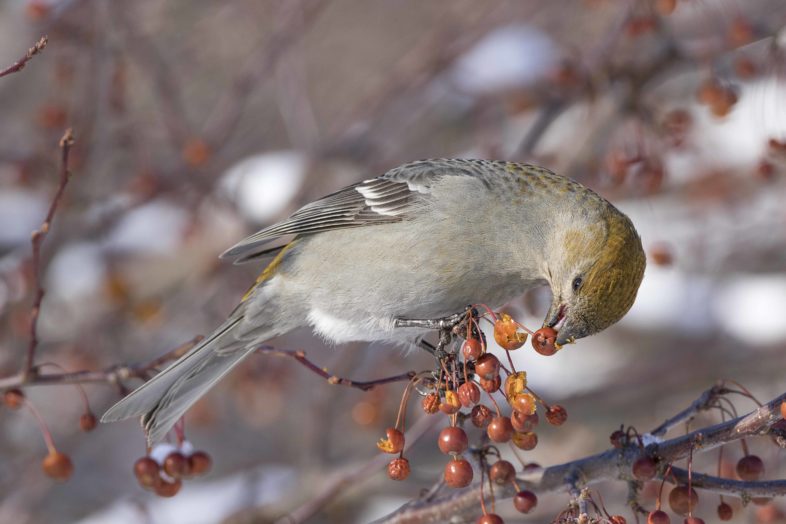
A female Pine Grosbeak gorging on crab apples. This nomadic, fruit-loving finch from boreal Canada is staging an irruption in northern New England, and its numbers are building as winter progresses. © K.P. McFarland – kpmcfarland.com
